
Regular car tyre examination can prevent many longer term problems and should be performed regulargly. At JAX Tyres & Auto we recommend you examine the following scenarios for peace of mind:
Objects Embedded in the Tyre Tread
Remove all stones and other objects embedded in the tyre tread before driving.
Tyre Tread Wear
Ensure tyres have adequate tread depth. If your tyres are worn to the tread-wear indicators they must be replaced. Tyre wear indicators are positioned at equal distances around the tyre and may be located by the symbol TWI in the very upper part of the sidewall in the shoulder area where that meets the start of the tread pattern.
Tyre Sidewall Condition
If there are bulges and cuts, have the tyre examined by JAX Tyres & Auto, as the damage may be more serious than it appears.
Note: Tyres showing wear on one side, or showing feathered edges to the tread pattern, are often indicative of mechanical maladjustment. The vehicle's steering, or suspension geometry may need to be checked, and the wheels aligned.
WARNING! All punctured or damaged tyres must be removed from the wheel for internal and external examination to ensure there is no hidden secondary damage which may later cause tyre failure. Puncture repairs must meet Australian standards.
Repairs to Run Flat Tyres
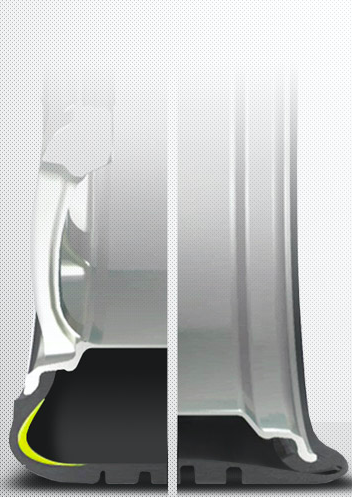
A number of leading car manufacturers, have started to equip their vehicles with Run Flat or Mobility Tyres.
This revolutionary tyre design allows the vehicle to continue moving despite a loss of tyre pressure and is able to function as a "get home" solution. This avoids the inconvenience of all that may be associated with changing the tyre at the roadside.
Run flat tyres are designed to have a "get you home capability" and depending on the particular tyre brand, can be operated up to a distance of 100km, provided the maximum speed of the vehicle does not exceed 80km/hr.
When punctured and operated in a deflated state, the tyre condition will have to be carefully assessed to evaluate the suitability and integrity of the tyres casing prior to carrying out any repair.
There are specific guidelines for the repair of run flat tyres and it should be noted that not all tyre manufacturers approve of the repair to their products.
Manufacturers' Recommendations
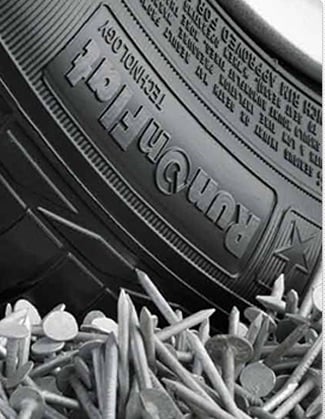
Prior to repair, JAX Tyres & Auto will conduct a thorough examination to ensure the suitability of conducting a repair to a run flat tyre, in accordance to the Australian Tyre Standard, the tyre manufacturer's recommendations and any damage likely to be caused by the tyre running underinflated.
Bridgestone - Not all Bridgestone run flat tyres are repairable. Only if the tyre is marked on its sidewall 'Repairable RFT' can the tyre be repaired in accordance to the Australian Tyre Repair Standard.
Continental - In accordance to Continental's technical recommendations, their Self Supporting Runflat (SSR) tyres may be repaired in accordance to the Australian Tyre Repair Standard.
Dunlop - In accordance to Dunlop's technical recommendations, their Dunlop Self-Supporting Technology (DSST) or RunOnFlat (ROF) tyres may be repaired in accordance to the Australian Tyre Repair Standard.
Goodyear - In accordance to Goodyear's technical recommendations, their Extended Mobility Technology (EMT) or RunOnFlat (ROF) tyres may be repaired in accordance to the Australian Tyre Repair Standard.
Hankook - In accordance to Hankook's technical recommendations, their runflat tyres cannot be repaired after being punctured and must be replaced.
Michelin - In accordance to Michelin's technical recommendations, Michelin's Zero Pressure (ZP) tyres may be repaired in accordance to the Australian Tyre Repair Standard, but limited to only one repair (unless marked 'non-repairable' on sidewall).
Pirelli - In accordance to Pirelli's technical recommendations, Pirelli's Run Flat (R-F/RFT) and Runforward tyres may be repaired in accordance to the Australian Tyre Repair Standard.
Tyre Performance and Wear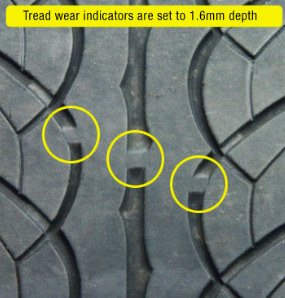
Throughout the life of a tyre, its performance gradually decreases, compromising your safety particularly when driving in the wet. In these conditions, the tyre's ability to provide adequate grip when accelerating, cornering and braking reduces to unacceptable levels at the minimum tread depth of 1.6mm.
For these reasons, most manufacturers recommend replacing worn tyres at a minimum tread depth of 3mm.
Repairs to Self Sealing Tyres
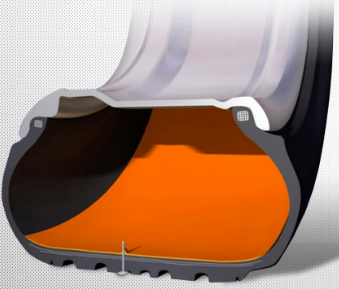
Repairs to Seal Inside Tyres may be made in accordance to the Australian Tyre Standard.
Following a penetration, during the repair procedure it will be necessary to remove the internal sealant in the area of the penetration equal to the size of the repair patch to expose the impermeable butyl liner.
The removal of the sealant will mean that the patched area will lose its special technical characteristics of a Seal Inside tyre
Standard Repairs
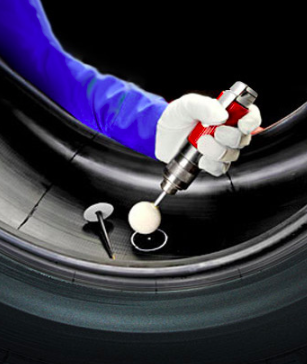
- Punctured tyres to be repaired, must always be removed from the wheel for inspection
- JAX Tyres & Auto will ensure that your tyre is repaired according to the Australian Tyre Repair Standard
- Any penetration causing a hole in the tread area not exceeding 6mm diameter may be repaired
- If the penetration is greater than 6mm or is localised either in the sidewall, shoulder or bead area of the tyre then it is unrepairable and must be replaced to ensure that your safety is not compromised
Not all tyres can be fixed. In fact, it’s actually illegal to attempt to repair tyres that have the following conditions:
- If the tread depth is below 1.6mm. Before attempting a tyre change, you should check your tyre’s original nominal width concerning your current tyre. You can find this in your owner’s manual. You can only repair the car and van tyres within the central 60-70% of the tyre’s nominal width.
- Tread punctures greater than 6mm. This limit means that you can usually repair a tyre damaged by a screw or a nail. However, if your tyre is split or cut, a repair is unlikely to meet the above safety criteria.
- Compromised structural integrity. Tyre sidewalls are off limits to repairs as these take most of the load when in use.
- Deteriorated rubber or worn-out tyre: When the tyres are worn-out, their tread disappears and can no longer effectively grip the road properly. It is illegal to drive on bald tyres.
Chat to your local JAX tyre representative for a professional recommendation if you’re unsure whether to repair or replace your badly punctured tyre.
Your tyre sidewall is vital to the tyre’s performance and structure; any damage to this part would make the tyre dangerous to drive on, and would require a replacement. Unlike the tread area, you can’t repair the sidewalls. The sidewall takes most of the load when it’s in use; in many cases, the damage affects the whole structure of the tyre.
You can usually tell if you have damaged the tyre’s sidewall by seeing a deep scratch or a bubble on the sidewall. Also, if you can see the threads, which are often located 3-4.5mm into the tyre, it’s time to replace it.
Tyres can suffer variable degrees of damage due to a puncture. The severity of the injury depends on which specific part of the tyre you punctured and how deep it is. It’s illegal to repair your tyre’s bead, sidewall, or shoulder area.
- The tyre sidewall. Unlike the tread, you cannot repair the sidewall. The sidewall is vital to the performance and the structure of the tyre, and often any visible damage to the tyre sidewall majorly compromises the structural integrity of the entire tyre sidewall.
- Tyre bead. A tyre’s bead must be able to take a great deal of force. The bead is constructed with strong cords to withstand the tyre’s air pressure. If any cords are compromised, you should always replace the tyre.
- Tyre shoulder: Like the tyre sidewall, the shoulder is essential for the tyre’s structural integrity. Once the sidewall is damaged, you must replace the tyre instead of fixing it.
Alternatively, a tyre is repairable when:
- Is punctured less than 6mm. Small objects like screws and nails generally cause small holes on the tyre, which lead to a slow puncture. In these cases, while you should get the puncture fixed immediately, they are repairable.
- The puncture is less than 5mm in diameter. The hole can easily be patched and sealed as it is relatively small.
A sidewall tyre is unsafe to drive around with and should not be repaired. By law, a tyre is only repairable if the damage is less than 6mm deep and 5mm in diameter. Anything larger than this or damage to the tyre wall, tread or shoulder cannot be repaired and only replaced. Unlike the tread, if there is damage to the tyre sidewall, the whole structure is compromised and can blow at any moment.
The short answer is yes. A cut tyre, no matter the size, which exposes cords is illegal.
Tyre cuts result from external elements such as rough road conditions, protruding bodywork parts, or sharp foreign objects such as glass or stone. Luckily it’s possible to travel up to a few hundred metres before you irreversibly destroy the tyre. This is enough distance for you to come to a stop safely.
Driving on a damaged, cut tyre can cause internal structural damage to the tyre and can put you and your passengers in considerable danger. If your tyre is damaged, replace the tyre with your spare tyre, visit the nearest local mechanic, and have your tyres checked immediately by an expert.
Driving on a badly punctured tyre can put you and the people around you at grave risk. However, When a puncture is within limits established by the industry and properly repaired, the tyre can continue to deliver thousands of kilometres of safe and reliable performance. A tyre is beyond repair if:
Never repair tyres with a tread puncture deeper than 6mm.
Never repair tyres outside the tyre’s 60-70% nominal width.
Never repair a tyre with damage to the tyre’s sidewall, shoulder or beads.
You can replace not all tyres. Some tyres have specific limits based on the recommendations and repair policy of the tyre manufacturer. Check your owner’s manual to see whether you can repair your particular type of tyre.
If a tyre is repaired wrong, the results can be deadly. Be sure to ask your local JAX representative if your tyre should be replaced or repaired.
We’ve matched your registration number Sorry, we couldn’t find a match for registration number !
- Wheels
- Services & Repairs
-
Tyres
- Shop the Best Electric Vehicle Tyres: Upgrade Your Ride
- Snow tyres in Australia?
- Snow chains | Jax Tyres
- Buy Performance & Semi Slick Tyres
- Buy Light Truck & Commercial Tyres
- Buy Trailer & Caravan Tyres
- Buy All-Terrain, Off-Road & Mud Tyres
- Buy 4WD & SUV Tyres
- Tyre Pricing
- My Jax Platinum
- ECE 30 & 54 Regulations
- Uniform Tyre Grading System
- Tyre Inflation Pressures
- How to Understand Tyre Speed Rating
- Trailer & Caravan Tyres
- 4WD Driving Tips
- Plus One Tyre Sizing: Learn How To Plus Size Tyres & Wheels
- Tyre Choice
- Legal Tips
- Mercedes Original Equipment Extended Mobility (MOE) Markings
- Tyre Talk - What Do the Numbers Mean?
- What is tyre rotation?
- Understanding Tyre Load Rating
- Tyre Placard
- Tyre Examination & Repair
- When fitting just two tyres
- Tyre Repair Services
- Tyres and Wheels
- Second Hand Tyres
- Bald Tyres
- TPMS
- Run Flat Tyres
- Your guide to space saver tyres
- How to Change a Tyre
- Light Truck Tyres vs Commercial
- Low Profile Tyres
- Gearboxes explained
- Tyre Slime explained

